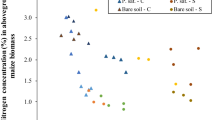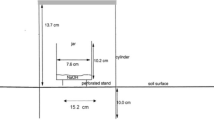Abstract
The research is focused on an ecologically sound and highly productive cultivation system for fodder and/or biomass for thermal power generation on the basis of winter legumes and maize as subsequent summer crop, managed without additional nitrogen fertiliser. Therefore the yield of biomass and N-fixing capacity of a winter pea (Pisum sativum L.) and crimson clover (Trifolium incarnatum L.) monocropped and intercropped with rye (Secale cereale L.) were examined for five years in a field trial. In mid-June above-ground biomass of winter crops was removed and maize transplanted. The winter crops achieved maximum dry matter yield about three to five weeks before maturity. Mixed stands yielded more biomass than pure stands and exhibited greater yield stability. The relative advantage of intercropping, expressed as land equivalent ratio (LER), determined for intercropped winter pea/rye were 1.1 to 1.2 and for crimson clover/rye 1.3. At maturity, the amount of fixed nitrogen ranged between 178 kg N for crimson clover and 242 kg N ha-1 for winter pea, respectively. At the end of anthesis (middle of June, harvesting stage for silage fodder) 75% and 88% of the total fixed nitrogen was achieved, for clover and pea, respectively. In intercropping the amount of fixed nitrogen was lower than in pure stands due to a lower seed density of the legume; however, the N-fixing efficiency was greater than in pure stands. N-release of the winter pea in a pure stand produced a maximum yield in maize (Zea mays L.) without additional N-fertiliser. An additional N mineral fertilisation of 75 to 150 kg N and 75 to 225 kg N was necessary to achieve maximum yields in maize following intercropped winter pea and crimson clover, respectively. Legumes in mixed stands with rye resulted in lower amounts of residual nitrogen after maize harvest. The beneficial effect of legumes on maize can be divided into N-effects and rotation effects. Both effects were positive regarding winter pea. The rotation effect of crimson clover in pure stands on maize was negative. Allelopathic effects and the high sensitivity of crimson clover to mineral nitrogen in the soil, released by residues of the preceding crop, winter rape (Brassica rapa L.), were discussed as the reason for this observation. The combination of the winter pea in pure stand and maize achieved the highest total biomass yield from winter and summer crops, unfertilised (156 dt ha-1 dry). The combinations of intercropped legumes and maize produced biomass yields of 142 to 145 dt ha-1. Because winter pea is highly susceptible to lodging, intercropping with low seed density of rye is recommended (3/4 winter pea, 1/4 rye). The rye crop prevents lodging by providing support and high rates of N-fixation are achieved with high seed density of pea. Intercropping with crimson clover and rye should be based on high seed densities of legumes, too because rye is highly competitive within those mixtures.
Similar content being viewed by others
References
Baldock J O, Higgs R L, Paulson W H, Jackobs J A and Shrader W D 1981 Legume and mineral N effects on crop yields in several crop sequences in the Upper Mississippi Valley. Agron. J. 73, 887–890.
Cornelius P L and Byars J 1976 Lattice designs for unreplicated yield trials of maize varieties at several plant densities. Crop Sci. 16, 42–49.
Cornelius P L 1978 Empirical models for the analysis of unreplicated lattice-split-plot cultivar trials. Crop Sci. 18, 627–633.
Fox R H and Piekielek WP 1988 Fertiliser N equivalence of alfalfa, birdsfoot trefoil, and red clover for succeeding corn crops. In Torbert H A et al. 1996 Winter Legume Cover Crop Benefits to Corn. Rotation vs. Fixed-Nitrogen Effects. Agronomy J. 88, 527–535.
Fukai S and Trenbath B R 1993 Processes determining intercrop productivity and yields of component crops. Field Crops Res. 34, 248–270.
Jackson L E, Wyland L J and Stivers L J 1993 Winter cover crops to minimize nitrate losses in intensive lettuce production. J. Agric. Sci. 121, 55–62.
Kahnt G 1983 Gruenduengung. Verlagsunion Agrar, DLG-Verlag, Frankfurt (Main), 2. Auflage.
Karpenstein-Machan M, Scheffer K and Pahmeyer E 1992 Zweifruchtanbau - eine Chance fuer alternative Energiegewinnung. Mais 3, 24–26.
Karpenstein-Machan M 1997 Konzepte fuer den Energiepflanzenbau; Perspektiven eines pestizidfreien Anbaus von Energiepflanzen zur thermischen Verwertung im System der Zweikulturnutzung. DLG-Verlags-GmbH, Frankfurt, 1997, 67 Tab., 54 Abb., ISBN-3-7690-0546-5.
Koehnlein J and Vetter H 1953. Emterueckstaende und Wurzelbild. Verlag Paul Parey Hamburg und Berlin. Landessortenversuche der Landwirtschaftskammer Hannover: Versuchsergebnisse 1988–1990. Publisher: Landwirtschaftskammer Hannover.
Marschner H 1995 Mineral nutrition of higher plants. Academie Press, Muenchen, 2nd edition.
Pare T, Chalifour F P, Bourassa J and Antoun H 1992 Forage corn dry-matter yields and N uptake as affected by previous legumes and N fertiliser. Can. J. Plant Sci. 72, 699–712.
Power J F and Broadbent F E 1989 Proper accounting for N in cropping systems. In Ranells N, Wagger M G, 1996. Nitrogen release from grass and legume cover crop monocultures and bicultures. Agronomy J. 88, 777–782.
Ranells N and Wagger M G 1996 Nitrogen release from grass and legume cover crop monocultures and bicultures. Agronomy J. 88, 777–782.
Rao M R, Rego T J and Willey R W1987 Response of cereals to nitrogen in sole cropping and intercropping with different legumes. Plant Soil 101, 167–177.
Reeves D W and Wood C W 1994 A sustainable winter-legume conservation tillage system for maize. Effects on soil quality. In Torbert H A et al. 1996. Winter legume cover crop benefits to corn. Rotation vs. fixed-nitrogen effects. Agronomy J. 88, 527–535.
Reeves D W 1994 Cover crops and rotations. In Torbert H A et al. 1996. Winter legume cover crop benefits to corn. Rotation vs. fixed-nitrogen effects. Agronomy J. 88, 527–535.
Ries S K, Wert V, Sweeley C C and Leavitt R A 1977 Triacontanol. A new naturally occurring plant growth regulator. In Torbert H A et al. 1996. Winter legume cover crop benefits to corn. Rotation vs. fixed-nitrogen effects. Agronomy J. 88, 527–535. SAS Institute Inc. 1990. SAS User's Guide. Statistics. SAS Institute Inc., Cary, NC.
Scheffer K 1985 Das Pflanzen von Mais, eine neue Methode zur Steigerung der Flaechenproduktivitaet und zur Verhinderung von Bodenerosion. Mais 1 10–13.
Scheffer K 1997 Transplanting of sweet sorghum to reduce competition and soil erosion in a double crop system. Prodeedings of the first International Sorghum Conference, Peking, 229–231.
Scheffer K 1998 Use of wet biomass for thermal power generation, oil and fiber production. In Leihner D E and Th A Mitschein (ed.): A third Millenium for humanity? The search for paths of sustainable development. Proceedings of the Conference ‘Forum Belém I’, Nov. 26-29, 1996, Belém do Pará, Brazil, Europaeischer Verlag der Wissenschaften, Frankfurt/Main, ISBN 3-631-34976-1, 383–391.
Scheffer K and Karpenstein-Machan M 1991 A New environmentally beneficial cropping system and a new method of energy production. In Economically efficient and environmentally sound energy strategies for sustainable food production (Proceedings of a workshop), 89–96.
Scheffer K and Stuelpnagel R 1993 Wege und Chancen bei der Bereitstellung des CO2-neutralen Energietraegers Biomasse - Grundgedanken zu einem Forschungskonzept. Der Tropenlandwirt, Beiheft 49, 147–161.
Siame J, Willey R W and Morse S 1998 The response of maize/phaseolus intercropping to applied nitrogen on Oxisols in northern Zambia. Field Crops Res. 55, 73–81.
Stoop W A 1986 Agronomic management of cereals/cowpea cropping systems for major toposequence land types in the West African savanna. Field Crops Res. 14, 301–319.
Stuelpnagel R 1982 Schaetzung der von Ackerbohnen symbiontisch fixierten Stickstoffmenge im Feldversuch mit der erweiterten Differenzmethode. Z. Ackerund Pflanzenbau 151, 446–458.
Stuelpnagel R 1992 lntercropping of faba beans (Vicia faba L.) with oats or spring wheat. Proceedings of the International Crop Science Congress, 14-22 July 1992, Iowa State University, Ames, Iowa.
Stuelpnagel R 1997 Dry or humid biomass from agriculture for energy. In Books of Abstracts. International Conference on sustainable agriculture for Food, Energy and Industry. FAO Braunschweig, page 69.
Stuelpnagel R and Scheffer K 1983 Zur N-Nachwirkung der Ackerbohnen (Vicia faba L.) in einem Fruchtfolgeversuch mit differenzierter Stickstoffduengung. Landwirtsch. Forschung 36, 27–35.
Stuelpnagel R and Scheffer K 1988 Zum Vorfruchtwert der Ackerbohne - Ergebnisse aus einem Dauerversuch. VDLUFASchriftenreihe 28, Kongressband Teil II, 443–453.
Torbert H A, Reeves D W and Mulvaney R L 1996 Winter legume cover crop benefits to corn. Rotation vs. fixed-nitrogen effects. Agronomy J. 88, 527–535.
Willey R W 1979 lntercropping its importance and research needs. I. Competition and yield advantages, II. Agronomy and research approaches. Field Crop Abstracts 32, 1 10, 73–85.
Author information
Authors and Affiliations
Rights and permissions
About this article
Cite this article
Karpenstein-Machan, M., Stuelpnagel, R. Biomass yield and nitrogen fixation of legumes monocropped and intercropped with rye and rotation effects on a subsequent maize crop. Plant and Soil 218, 215–232 (2000). https://doi.org/10.1023/A:1014932004926
Issue Date:
DOI: https://doi.org/10.1023/A:1014932004926




